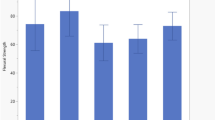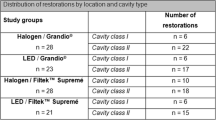Abstract
Objective
Clinical data indicate an increased trend in material fracture as reason for failure in composite restorations, questioning whether modern resin-based composites (RBCs) are able to fulfil the rising aesthetical demands and to provide at the same time a sufficient mechanical stability also in larger cavities. Nano-hybrid RBCs are promoted as materials with improved mechanical properties. The aim of this study was to analyse differences in mechanical properties within and between modern flowable and non-flowable nano-hybrid and micro-hybrid RBCs by measuring mechanical properties at macro- and micro-scale.
Methods
Thirty-four RBCs with traditional and new monomer formulation or photo-polymerization initiator technology—15 nano-hybrid, nine micro-hybrid and ten flowable—were therefore considered. Flexural strength, flexural modulus (Eflexural), indentation modulus, Vickers hardness (HV) and creep were measured after the samples had been stored in water for 24 h at 37°C. Differences within the materials as well as within material categories were statistically analysed using one-way ANOVA with Tukey HSD post hoc test (α = 0.05) as well as partial eta-square statistics.
Results
The category of micro- and nano-hybrid RBCs performed in all properties superior compared to the flowable RBCs. The former two categories differ significantly only with regard to three parameters, with nano-hybrid RBCs showing higher HV respectively lower Eflexural and filler weight. The micro-mechanical parameters proved to be more sensitive to differences in filler amount and RBCs type than the macro-mechanical properties.
Clinical relevance
Only few differences were found between nano-hybrid and micro-hybrid RBCs as a material category and thus, from laboratory tests, no clear advantages in the mechanical stability in stress-bearing areas of nano-hybrid RBCs are expected clinically. Similar is valid for materials with new monomer formulation or photo-polymerization initiator technology. However, several of the measured nano-hybrid RBCs showed consistently higher mechanical properties than the mean values of the micro-hybrid RBCs.
Similar content being viewed by others
References
Sarrett DC (2005) Clinical challenges and the relevance of materials testing for posterior composite restorations. Dent Mater 21:9–20
Brunthaler A, Konig F, Lucas T, Sperr W, Schedle A (2003) Longevity of direct resin composite restorations in posterior teeth. Clin Oral Investig 7:63–70
van Dijken JW (2000) Direct resin composite inlays/onlays: an 11 year follow-up. J Dent 28:299–306
Van Nieuwenhuysen JP, D'Hoore W, Carvalho J, Qvist V (2003) Long-term evaluation of extensive restorations in permanent teeth. J Dent 31:395–405
Trujillo-Lemon M, Ge J, Lu H, Tanaka J, Stansbury J (2006) Dimethacrylate derivates of dimer acid. J Polymer Sci 44:3921–3929
Reiners J, Podszun W, Winkel J (1990) (Meth)acrylic acid derivates of tricyclo(5.2.1.02.6)decanes containing urethane groups Europe: BAYER AG
Kurokawa R, Finger WJ, Hoffmann M, Endo T, Kanehira M, Komatsu M, Manabe A (2007) Interactions of self-etch adhesives with resin composites. J Dent 35:923–929
Marchesi G, Breschi L, Antoniolli F, Di Lenarda R, Ferracane J, Cadenaro M (2010) Contraction stress of low-shrinkage composite materials assessed with different testing systems. Dent Mater 26:947–953
Utterodt A (2008) Dental composites with Tricyclo[5.2.02.6]decane derivatives Europe: Heraeus Kulzer GmbH (Hanau, DE)
Utterodt A (2008) Compositions for dental composites with tricyclo[5.2.1.02.6]decane derivates. United States: Heraeus Kulzer GmbH (Hanau, DE)
Koo JH (2006) Processing of Nanomaterials. In: Polymer nanocomposites: processing, characterization, and applications, McGraw-Hill, New York, pp 61–75
Wagner D, Vaia R (2004) Nanocomposites: issues at the interface. Mater Today 7:38–42. doi:10.1016/S1369-7021(04)00507-3
Ilie N, Hickel R (2009) Investigations on mechanical behaviour of dental composites. Clin Oral Investig 13:427–438
Ilie N, Hickel R (2009) Macro-, micro- and nano-mechanical investigations on silorane and methacrylate-based composites. Dent Mater 25:810–819
Curtis AR, Palin WM, Fleming GJ, Shortall AC, Marquis PM (2009) The mechanical properties of nanofilled resin-based composites: characterizing discrete filler particles and agglomerates using a micromanipulation technique. Dent Mater 25:180–187
Curtis AR, Palin WM, Fleming GJ, Shortall AC, Marquis PM (2009) The mechanical properties of nanofilled resin-based composites: the impact of dry and wet cyclic pre-loading on bi-axial flexure strength. Dent Mater 25:188–197
Lohbauer U, von der Horst T, Frankenberger R, Kramer N, Petschelt A (2003) Flexural fatigue behavior of resin composite dental restoratives. Dent Mater 19:435–440
Maseki T, Nitta T, Yamase M, Yamada T, Ogawa S, Kimishima T, Nara Y, Dogon IL (2010) Characteristics in polymerization shrinkage of latest low-shrinkage resin composite restoratives. J Dent Res 89:457
Platt J, Macpherson M, Rhodes B (2010) Polymerization shrinkage and contraction stress of an experimental composite. J Dent Res 89:1024
Wei Y, Silikas N, Zhang ZT, Watts DC (2011) Hygroscopic dimensional changes of self-adhering and new resin-matrix composites during water sorption/desorption cycles. Dent Mater 27:259–266
Weinmann W, Thalacker C, Guggenberger R (2005) Siloranes in dental composites. Dent Mater 21:68–74
Bettencourt AF, Neves CB, de Almeida MS, Pinheiro LM, Oliveira SA, Lopes LP, Castro MF (2010) Biodegradation of acrylic based resins: A review. Dent Mater 26:e171–e180
Palin WM, Fleming GJ, Burke FJ, Marquis PM, Randall RC (2005) The influence of short and medium-term water immersion on the hydrolytic stability of novel low-shrink dental composites. Dent Mater 21:852–863
Bayne SC, Heymann HO, Swift EJ Jr (1994) Update on dental composite restorations. J Am Dent Assoc 125:687–701
Suzuki S, Leinfelder KF, Kawai K, Tsuchitani Y (1995) Effect of particle variation on wear rates of posterior composites. Am J Dent 8:173–178
Jin XB, Bertrand, S, Hammesfahr P (2009) New radically polymerizable resins with remarkably low curing stress. J Dent Res 88:1651
Ilie N, Hickel R (2011) Investigations on a methacrylate-based flowable composite based on the SDR technology. Dent Mater 27:348–355
Conflict of interest
The authors declare that they have no conflict of interest.
Author information
Authors and Affiliations
Corresponding author
Rights and permissions
About this article
Cite this article
Ilie, N., Rencz, A. & Hickel, R. Investigations towards nano-hybrid resin-based composites. Clin Oral Invest 17, 185–193 (2013). https://doi.org/10.1007/s00784-012-0689-1
Received:
Accepted:
Published:
Issue Date:
DOI: https://doi.org/10.1007/s00784-012-0689-1




